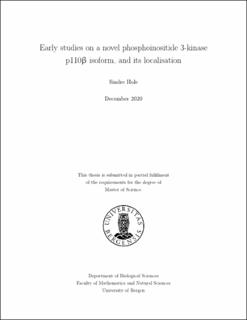| dc.description.abstract | Phosphoionositide 3-kinase (PI3K) is a family of enzymes that are part of the PI3K signalling pathway, which is one of the most often altered pathways in human cancer. The PI3K family is divided into three classes, where the class I produce phosphatidylinositol (3,4,5)-triphosphate (PIP3), a secondary messenger that acts upon several pathways and is linked to cancer. Of the four distinct isoforms of class I PI3K, the p110α, and p110β forms are ubiquitously expressed in all tissues. Most research has been conducted on p110α, due to the frequent observations of mutations in cancers. Less research has been done on p110β, but it has been shown to exhibit transforming properties when overexpressed. Both p110α and p110β exhibit high sequence homology as well as signalling properties. One difference is the subcellular localisation of these isoforms, p110β being the only one found in the nucleus. When our group determined the nuclear localisation of p110β in a panel of endometrial cancer cells; an additional nuclear protein of lower mass was detected using antibodies targeting different sites of p110β. The focus of this thesis was to investigate and explain the occurrence of the lower nuclear p110β form. During this study, we validated the detection of this p110β form using different antibodies. Its existence as a theoretical short form of p110β became a plausible explanation due to the following results. The theoretical form starts from an initiation codon at amino acid (aa) number 555, contains an insert of 5 aa, compared to canonical p110β, and is 521 aa long. To validate the existence of the short p110β isoform, the insert was detected by RT-PCR, and the theoretical ATG site for the short form was found to have a stronger Kozak sequence then the canonical ATG. The validity of the short form ATG to function as a start codon was tested by mutating either the canonical ATG or the short form ATG. This experiment was inconclusive; therefore, it needs to be repeated. Interestingly the p110β short form was found to be cytoplasmic, not nuclear. It also exhibited autophagy like patterning when overexpressed, at five times higher frequency than the canonical p110β. The canonical form as been implicated in autophagy, but these studies are controversial. Additional studies on the p110β short form may clarify theses findings. | |
